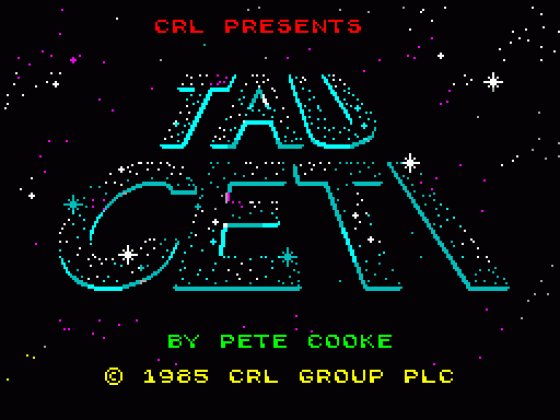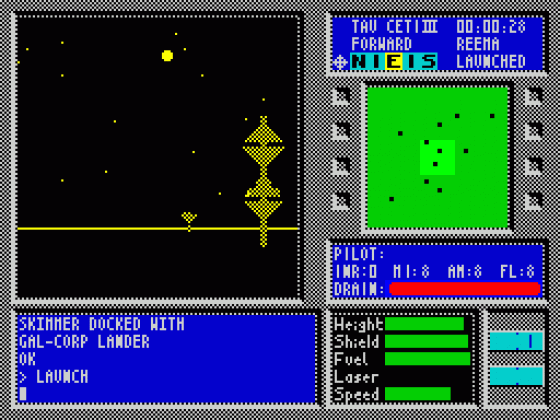
Computer Gamer
 1st December 1985
1st December 1985
Categories: Review: Software
Author: Tony Hetherington
Publisher: CRL
Machine: Spectrum 48K
Published in Computer Gamer #9
Tony Hetherington explores the new megagame from CRL
Tau Ceti
Tony Hetherington explores the new megagame from CRL.
Imagine a cross between Impossible Mission, Elite, Quake Minus One and Battlezone and you'll imagine Tau Ceti.
Then try to fit it all into a Spectrum with space left for planet maps, building interiors and even a notepad and you'll have a game heading straight for the top of the charts.

The game is set on the third planet in the Tau Ceti system (Tau Ceti 3) in the far future. You control a one man skimmer craft that has just been dropped on the planet. Ahead of you lies an impossible mission.
Twenty reactor pods lay in forty pieces spread throughout the Reactor substations in thirty cities. Your task is to collect and reassemble them in the main reactor building in Centralis (Tau Ceti 3's capital) closing down the planet's power source. This will shut down the old defence systems that malfunctioned after a plague wiped out the colonists clearing the way for recolonisation of the planet.
This isn't going to be very easy since the robot hunters, guardian crawlers, mines and armoured fortresses of the defense systems are determined to stop you.
Gal-corp Skimmer
The game starts as a Lander drops you in your skimmer on the planet's surface with the screen its instruments and controls.
This display is split into three areas, a view screen, command area and instrument panel.
The instruments include a radar screen and compass for navigation as well as two ADF's (Automatic Direction Finders) to direct you to the centre of the city or back to your lander. Beneath those are indicators to show present levels of missiles, anti-missiles and flares on board the ship as well as dispayed showing the skimmer's current speed, height, fuel, laser power and shield strength. If this last one reaches zero the skimmer, with you onboard is destroyed and the game is over.
Using definable single keys, the skimmer can be flown across the planet's 3D landscape and enemies can be fought with lasers and missiles.
The screen to the left of the instruments panel shows the view of the planet in front of the skimmer. At the touch of a key, this can be swapped to a side or back view, which is extremely important in combat as lasers and missiles can be fired in any direction. This means you can keep on your present course for a substation while swapping to other views to fight off attacking ships.
The landscape views are impressively drawn as the solid shaes of the cities buildings move smoothly from when they appear on the horizon till they pass by the ship. The scene is completed by a starry sky with a setting sun and even an occasional comet.
As the sun sets the view becomes darker and less distinct until all detail is lost at night. Then you must switch to IR (Infra-Red) display which, although passable, causes a blurred picture because of after-images. Consequently, you should always be ready to launch a flare as soon as you come under fire as the temporary light from it will give you a better chance to sight your lasers.
When you find and dock with a building the view screen doubles up as a terminal for your onboard as well as showing the interior of the building.
By typing instructions into the command area, you can punch up a map, refuel and repair your skimmer, mae notes on your notepad, save and load the game position and attempt to solve the problem of matching up the rod sections.
The map shows the network of "jump stations" that connect the planet's 30 cities and by selecting icons the map display can be zoomed in and out and scrolled over the map. The jump stations themselves are one direction transporters and are the only way of getting from one city to another. The map is invaluable in locating the stations as if a map connection leads to the north then a station will be found north of the city and so on.
As mentioned in the introduction, the object of the game is to collect the 40 rod segments that are scattered throughout the city's reactor substations. The actual number you find in each substation varies from none to a maximum of around five.
Using the ship's computer you can try and match them into the right pairs. Again using icons each piece can be mirrored and shaded in a bewildering number of combinations until a match is found, or simply binned for later use.
The computer also controls refuelling and repairs which are performed at supply stations. One can be found in each city but be warned that some are civilian only and don't stock missiles or anti-missiles.
Finally, the computer includes a digital notepad that can be used to store any records or reminders that may be useful later in the game. This isn't just a quaint touch but is an invaluable aid if you are to complete the game. Since you can save the game and return to it later, a record of where you've been and which rods you've collected will ensure you get back to the action a lot quicker than hunting for the scrap paper you would have used.
Winning Ways
Saving the game positions after every two or three reactor substations will dramatically improve your chances of completing your mission, as one mistake could not only cost you your one life but also hours of playing time. This is particularly important when tackling some of the more heavily guarded cities as several attempts may be necessary until you find the right tactics.
Combat is an acquired skill which improves gradually with practice as you become acclimatised to the problems facing you. Usually you are badly out-numbered by defenders that not only fire lasers at you but also the odd missile. It's important to use all four views to track the enemy as attempting to turn the skimmer takes time and costs a lot in shield strength. Your missiles are heat-seeking and available free from military supply stations so if your stocks are good, you should loose some off against those defenders without anti-missiles leaving a manageable number for your lasers.
Combat is just one of the problems you will face as you have to navigate around and between the cities. A useful tip is that, if you get completely lost, you can drop your height and speed to land when you consult the map or your notepad. This will at least give you the compass bearing of the jump stations which should get you back on the right track.
I've still to face the challenge of cities guarded entirely by anti-missile forces and minefields to navigate and, of course, the main reactor itself.
Conclusions
Tau Ceti is without doubt a remarkable game. The complexity and content of the game appears too great for a Spectrum to hold, yet it has been achieved without a hardware addon in sight.
The challenge it poses is immense and will take its players months to complete.
It has obviously been inspired by such classics as Elite and Impossible Mission yet it remains original in its atmosphere and gameplay. I was particularly impressed by the attention to detail such as the comets in the sky, the IR displays after image and even a bleep as the ship's computer comes on-line.
CRL intend to follow up the Spectrum version with an Amstrad conversion and even threaten an Amstrad disc-based Tau Ceti plus with even more packed in it. For example, rooms to explore in the substations and supply buildings instead of static illustrations.
Tau Ceti is a must for all Spectrum owners and costs £9.95.
Other Reviews Of Tau Ceti For The Spectrum 48K
Tau Ceti (CRL)
A review
Tau-Ceti (CRL)
A review by Sue Denham (Your Sinclair)
Tau Ceti (CRL)
A review
Tau Ceti (CRL)
A review by Chris Bourne (Sinclair User)
Tau Ceti (CRL)
A review
Other Spectrum 48K/128K/+2 Game Reviews By Tony Hetherington
Scores
Spectrum 48K Version| Originality | 60% |
| Graphics | 100% |
| Use Of Machine | 100% |
| Value For Money | 100% |
| Overall | 90% |













